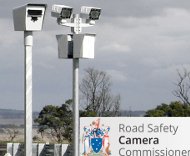10/8/2012
Australia: State Caught Exploiting Short Yellow Signal TimesVictoria, Australia caught issuing red light camera tickets at intersections where yellow had been too short for seven years.

A court challenge forced officials in Victoria, Australia to admit last week that red light cameras at eight intersections have been extremely productive because the yellow warning times were illegally short. The yellows fell short anywhere between 0.5 and 1.5 seconds with the incorrect timing in place, in one instance, for seven-and-a-half years.
At the intersection of Stud Road and High Street in Wantirna, for example, the yellow time was set at 3.0 seconds on December 28, 2006. Under VicRoads guidelines, it should have been 4.5 seconds, but the timing was not corrected until August 23. VicRoads only bothered to check the timing after a local man, Gordon Bishop, fought a ticket at Terminal Drive and Centre Road, near Melbourne Airport. The 3.0 second timing at that intersection fell short by 0.5 seconds of the requirement in a 50 km/h (31 MPH) zone. That half-second was enough to make this camera the state's second-biggest moneymaker. The court agreed with Bishop that the timing was illegal, though the state has appealed to avoid the prospect of paying $2.5 million in refunds.
After 3AW Radio made a big deal out of the shortened timing, VicRoads conducted an audit of timing at Victoria's 200 red light camera enforced intersections. VicRoads Chief Executive Gary Liddle refused to tell 3AW Radio on Friday how many motorists were affected or whether refunds would be issued for the citations that run $305 each. Because Australian photo tickets carry license points, it is possible that some drivers had their license suspended as a result of the improper timing.
"Those will be issues for the road safety camera commissioner to consider," Liddle said.
Motorists who received a ticket at one of the affected locations were told to wait for the ruling of the speed camera commissioner. As of last month, the timing at the intersections in question had been brought up to the VicRoads standard.
While a difference of 0.5 to 1.5 seconds in the length of the yellow light might seem insignificant, the extra margin of safety is critical. The vast majority of straight-through red light "violations" happen when a driver misjudges the end of the yellow light by less than 0.25 seconds -- literally the blink of an eye (view Texas Transportation Institute (TTI) chart). In most cases, a yellow shortened by one second can increase the number of tickets issued by 110 percent, according to a TTI report (view report).
A copy of the list of affected intersections is available in a 40k PDF file at the source link below.


